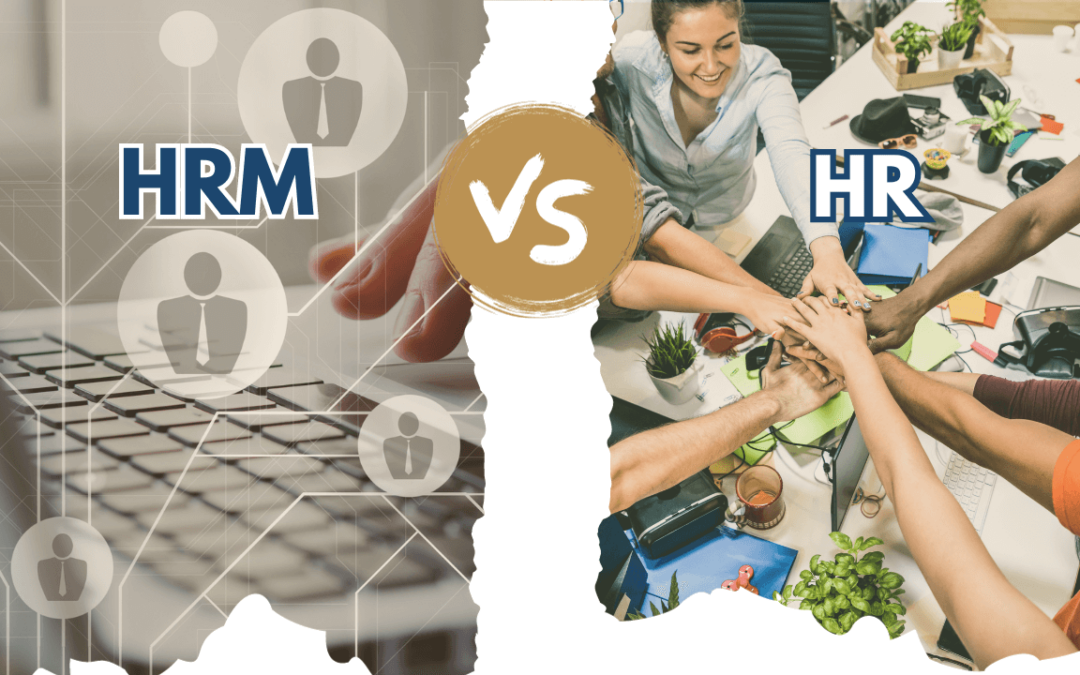Understanding the difference between HR and HRM is key in the business world. HR refers to the department handling employee-related tasks in a company. On the other hand, HRM is about the strategies and practices this department uses to manage and develop the workforce. This post will explore how each plays a unique role in a company’s growth and success.
What is HRM?
Human Resource Management (HRM) is a fundamental and dynamic aspect of any organization, primarily concerned with the management of people within organizations, focusing on policies and systems. HRM is often defined as the strategic approach to the effective management of people in a company or organization in a way that they help their business gain a competitive advantage. It is designed to maximize employee performance in service of an employer’s strategic objectives.
Meaning of HRM & What it Stands For
Human Resource Management (HRM) is the art and science of managing an organization’s workforce. It’s more than just hiring and firing; HRM is about strategically managing people, shaping workplace culture, and nurturing the human capital essential to a company.
HRM focuses on empowering employees to contribute effectively to the company’s mission, aligning their efforts with organizational goals. It encompasses strategic planning, people management, and facilitating change.
Effective HRM is crucial for any successful business, ensuring the workforce is managed with strategic insight and care, contributing significantly to achieving the company’s objectives.
What is IHRM
International Human Resource Management (IHRM) deals with managing human resources at an international level. It involves balancing global efficiencies and local responsiveness, and integrating human resources practices across different nations. The complexity of operating in different countries with different cultural, legal, and economic environments presents unique challenges in IHRM.
This includes managing expatriates, understanding various labor laws, adapting HR policies to align with local cultures, and managing diversity and inclusion on a global scale. IHRM plays a critical role in the success of multinational companies, as it ensures the right mix of skills and personalities to drive global business strategies.
What is DHRM
Domestic Human Resource Management (DHRM) refers to handling HR practices within the confines of a single nation. This involves understanding and applying the policies and procedures that are effective in the specific cultural, legal, and business environment of that country.
DHRM focuses on aligning HR strategies with domestic business needs, including compliance with local labor laws, recruitment and selection, employee relations, compensation and benefits, and performance management. It is tailored to meet the local needs and expectations of employees, which is crucial for maintaining employee satisfaction and productivity.

History of Human Resource Management
Human Resource Management (HRM) has evolved significantly through various eras.
During the Pre-Industrial Era, HRM was primarily about master-craftsmen hiring apprentices, focusing on personal relationships rather than formal processes.
The Industrial Revolution changed the work landscape dramatically. The rise of factories necessitated formal hiring processes, job specialization, and structured employee management, marking the start of organized worker management.
In the Early 20th Century, personnel management emerged, concentrating on employee welfare, labor relations, and compliance with labor laws. This period laid the groundwork for modern HR practices, highlighting worker well-being and rights.
A pivotal moment in HRM history was the Hawthorne Studies Era in the mid-20th century. These studies shifted the focus to employee motivation, leading to the development of organizational behavior as a field of study.
From the Late 20th Century to Present, HRM transitioned to strategic human resource management. This contemporary form aligns HR policies with business strategy, focusing on employee engagement, technology integration, and global workforce management.
Throughout its history, HRM has mirrored the economic, social, and technological changes of its times, evolving from a basic personnel management function to a strategic element in business success.

What is HR?
Human Resources (HR) stands at the heart of every organization, primarily concerned with managing its most valuable assets – its people. HR encompasses a broad range of functions and responsibilities, all focused on the effective management and optimization of the human capital in a company. This department acts as a bridge between the workforce and the management, ensuring that both the employees’ and the organization’s needs are met.
The role of HR is multifaceted, involving aspects such as recruitment, employee relations, performance management, training and development, compensation and benefits, and compliance with labor laws. In essence, HR is tasked with recruiting the right talent, nurturing and developing that talent, and maintaining a productive, safe, and satisfying work environment for all employees.
Meaning Of HR & What it Stands For
Human Resources (HR) is a term that captures the essence of how organizations manage and mobilize their human capital. HR represents the department within a company or organization responsible for everything related to the people’s side of the business. It’s about nurturing a workforce that aligns with the company’s objectives and culture. The term “Human Resources” underscores the idea that employees are valuable resources, vital to the success and growth of any organization.
What Does Human Resources Do
Human Resources (HR) is a vital component of any organization, encompassing a range of essential functions.
Recruitment & Staffing: A primary function of HR is managing recruitment and staffing. This includes identifying staffing needs, advertising job openings, screening candidates, and overseeing hiring to ensure the best talent joins the organization.
Employee Relations: HR plays a crucial role in maintaining positive employer-employee relationships. Responsibilities include addressing grievances, fostering a positive work culture, and enhancing employee engagement.
Performance Management: HR manages employee performance through setting standards, conducting reviews, and aligning individual goals with organizational objectives.
Training & Development: HR identifies and addresses training needs, organizes programs, and monitors their effectiveness, essential for employee and organizational growth.
Compensation & Benefits: HR designs and manages compensation structures and employee benefits, ensuring competitiveness and fairness.
Legal Compliance: Ensuring adherence to labor laws and managing employee records fall under HR’s responsibilities.
HR Policies & Procedures: HR develops and communicates policies and procedures, crucial for organizational operations.
Strategic Planning: HR contributes strategically by aligning its strategies with business goals and managing workforce planning.
History of Human Resources
The evolution of Human Resources mirrors the changing landscape of work and organizational needs through history.
In the Industrial Revolution (late 18th to early 19th century), the shift from agriculture to factory production initiated the era of personnel management, focusing on labor efficiency and productivity. This period marked the early stages of modern HR practices.
The early 20th century saw further evolution in HR with “Scientific Management” by Frederick Taylor and the Hawthorne Studies by Elton Mayo, emphasizing employee satisfaction and productivity. This marked a significant shift in worker management.
Post-World War II, the rise of large corporations required more structured HR departments, focusing on employee welfare, industrial relations, and labor law compliance.
By the late 20th century, globalization and technological advancements led to HR’s strategic role in talent management, organizational development, and aligning HR strategy with business goals.
In the 21st century, modern HR focuses on digital transformation, diversity and inclusion, and employee engagement, balancing strategic and advocacy roles. This phase highlights HR’s evolution from a support function to a key component in organizational strategy.
The history of HR reflects its continuous adaptation, evolving from basic personnel management to a strategic partner in the digital age.
Human Resources Purpose
Human Resource purpose is to shape and achieve business strategies, advocating for employee well-being, managing organizational change, and ensuring efficient operational management. Its purpose blends strategic planning with employee development, change facilitation, and administrative efficiency, crucial for any organization’s success.
The Importance of HR
HR is a vital component of any organization, The significance of HR in an organization cannot be overstated. It is instrumental in creating a productive, efficient, and harmonious workplace. HR professionals work behind the scenes to ensure that the company not only achieves its business objectives but also remains a great place to work for its employees.
They play a critical role in fostering organizational culture, developing leadership, and ensuring that the company adapts and thrives in a constantly changing business environment. Through its diverse functions, HR contributes significantly to the overall health and success of the organization, making it an indispensable part of the corporate world.

What is the Difference Between HR and HRM?
Understanding the distinction between Human Resources (HR) and Human Resource Management (HRM) is pivotal for any organization aiming to effectively utilize its workforce. While these two terms are often used interchangeably, they have distinct functions and scopes within the business environment.
Key Differences
- Scope and Focus: HR is primarily administrative, focusing on managing people, their employment, and compliance with labor laws. HRM, conversely, is broader and more strategic, focusing on managing people in a way that maximizes their contribution to the organization.
- Strategy and Planning: HRM involves more strategic planning compared to HR. HRM strategies are aligned with the business goals and objectives, whereas HR is more concerned with day-to-day operations.
- Employee Development: HRM places a strong emphasis on employee development, career growth, and ensuring that the workforce is future-ready. HR, while concerned with employee well-being, is less focused on long-term development.
- Role in Organization: HR is often seen as a support function, dealing with personnel management and administrative tasks. HRM is considered a key component in strategic planning and organizational development.
HR vs HRM
| Aspect | Human Resources (HR) | Human Resource Management (HRM) |
| Focus | Operational, dealing with the day-to-day management of staff | Strategic, focusing on long-term workforce development |
| Scope | Narrow, centered on employee administration and compliance | Broad, encompassing overall strategic workforce management |
| Strategy | Reactive, responding to immediate needs | Proactive, planning for future workforce requirements |
| Employee Growth | Limited focus on training and development | Strong emphasis on continuous learning and development |
| Role | Supportive, handling employee relations and issues | Integral, aligning HR strategies with business objectives |
Conclusion
The exploration into the differences between HR and HRM reveals that while they may be related and often function in tandem, their roles, scopes, and impacts on an organization are distinct. HR serves as the operational backbone, dealing with the day-to-day management of personnel, whereas HRM extends into a more strategic realm, shaping the workforce in alignment with the overarching business goals. In essence, HR lays the groundwork for HRM to build upon, with both playing indispensable roles in the tapestry of organizational success. This understanding is not just academically interesting but critically important for business leaders and HR professionals who strive to leverage their human resources effectively. As the corporate world continues to evolve, the roles of HR and HRM will undoubtedly adapt, but their core distinction will remain a cornerstone in the architecture of organizational management.
FAQ
Human Capital Management vs Human Resource Management
Human Capital Management (HCM) focuses on strategically optimizing the value of employees as assets, emphasizing their development and long-term potential. Human Resource Management (HRM) deals more with day-to-day management of personnel, including recruitment, training, and administration. HCM is a broader, more strategic approach, while HRM is more operational.
Difference Between Human Resource and Human Capital
Human Resource refers to the department within an organization responsible for managing all aspects of employee relations and workforce management. Human Capital, on the other hand, is the collective skills, knowledge, and other intangible assets of individuals that can be used to create economic value for the individuals, their employers, or their community.
Is it Human Resources or Human Resource
The correct term is Human Resources, emphasizing the diverse and collective aspects of the workforce in an organization.

